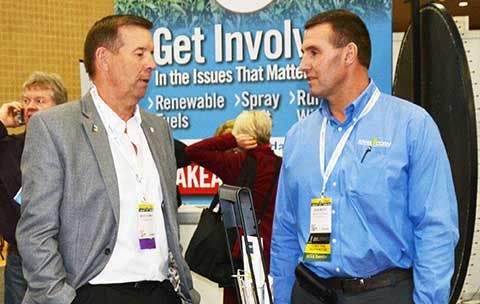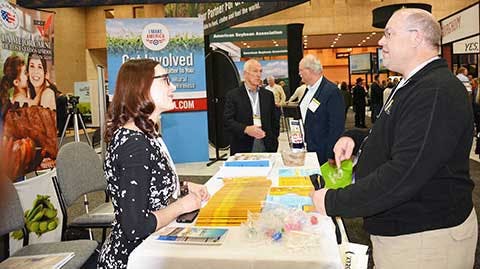Value of Red Meat Exports Shared at Commodity Classic
To show its appreciation for support received from soybean and corn producers and to share information about how red meat exports contribute to their profitability, USMEF participated in Commodity Classic in San Antonio. Conducted by the National Corn Growers Association, American Soybean Association, National Association of Wheat Growers and National Sorghum Producers, the annual convention and trade show attracts thousands of producers from across the country.

USMEF Chair Bruce Schmoll (left) talks with Iowa producer Dean Meyer during Commodity Classic in San Antonio
“When we have the chance to talk to soybean and corn producers who stop by the USMEF booth it gives the chance to connect one-on-one and really get the point across how red meat exports impact their bottom lines,” said USMEF Chair Bruce Schmoll, a soybean and corn producer from Claremont, Minnesota. “Commodity Classic provides a perfect opportunity to not only show our support for the grain industry, but also let them know that we are all part of the U.S. agricultural industry and we depend on each other.”
Schmoll, who was joined by USMEF feedgrains sector representative and Illinois corn producer Lou Lamoreux, distributed “Exporting Corn through Beef and Pork” brochures that detail a study showing the value of red meat exports to the corn industry.
“The study shows that U.S. red meat exports offers corn producers an extra 45 cents per bushel for their product, and when you add that up with the millions and millions of bushels of corn grown in this country, it’s quite substantial,” said Schmoll. “International trade plays a major role in U.S. agriculture and it affects how farmers like myself make a living. I think it’s important to share that with other producers.”
Trade was at the center of many discussions during this year’s Commodity Classic, as was the next farm bill. U.S. Rep. Mike Conaway, Chair of the House Committee on Agriculture, emphasized the importance of trade in a speech during the event’s general session. Conaway said he was pushing the Trump administration to move quickly on negotiating bilateral agreements, now that the U.S. has pulled out of the Trans-Pacific Partnership.

Producers from around the country visited the USMEF booth to learn about the value of red meat exports to the grain industry
He also shared with producers and ag industry representatives that President Donald Trump has said he wants, “a strong farm bill, and on time.” While heeding Conaway’s words and keeping an eye on activities in Washington, D.C., producers at Commodity Classic also focused on the fast-approaching spring planting season and learning about new equipment and innovations.
“We’re in a tough business but it’s what we do and what we love to do,” said Dean Meyer, who raises corn, soybeans, cattle and hogs in Rock Rapids, Iowa, while also serving on the USMEF executive committee. “The great thing about Commodity Classic is that you get to meet up with farmers from other parts of the country and you learn a lot just from those discussions.”
USMEF wrapped up Commodity Classic by hosting a luncheon for grain industry members. Lamoreux emceed the luncheon, which featured an address by Schmoll and an update on the global red meat market by USMEF President and CEO Philip Seng. Seng also fielded questions from the audience on USMEF activities in specific markets and key trade issues.
Seng praised the corn and soybean producers in attendance for their support of USMEF and their work in agriculture.
“I feel very strongly about what you do every day and what you mean to a lot of people around the world with the food products that you produce,” said Seng. “The average farmer today feeds 155 people around the world. There is no other industry that does that.”
